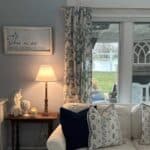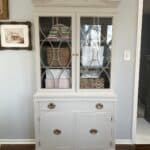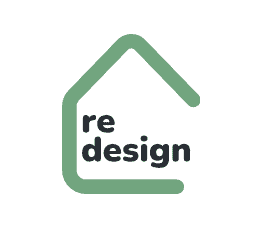Ideas for Creating Dark and Moody Interior Spaces
While my home doesn’t necessarily lend itself to dark and moody, it’s a design style that I absolutely adore. I love when it’s a dreary day outside and I can use lighting to make the dark corners of my home glow.
When you live on water I think the cottage core and coastal vibes just lend themselves better to your surroundings but if I could have a second home, it would be dark and moody with wainscotted walls painted a deep shade of navy or green, dark wallpapers adorning the walls and even painted ceilings for that cocoon-like feeling.
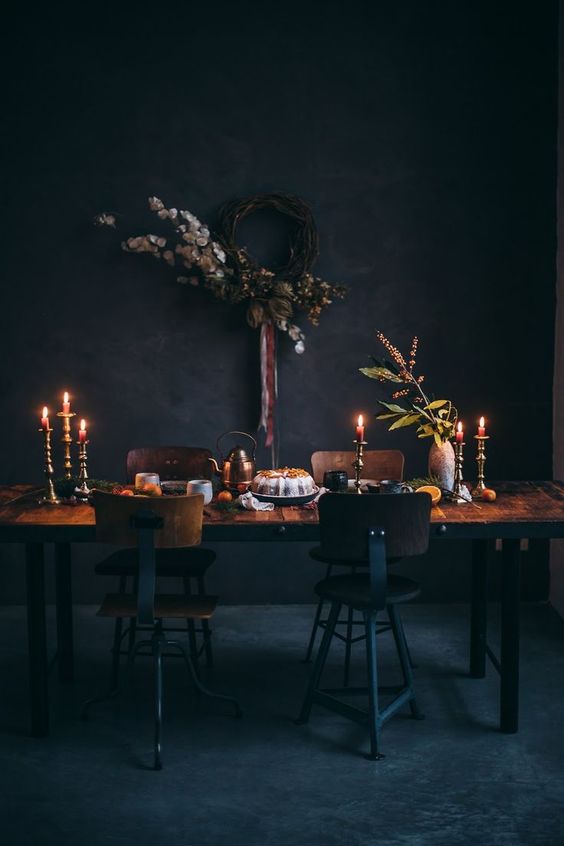
On my blog Living Large in A Small House, I may sometimes use affiliate links, which means a small commission is earned if you purchase via the link. The price will be the same whether you use the affiliate link or go directly to the vendor’s website using a non-affiliate link. You can find my full Disclosure Policy HERE
How to Create a Dark and Moody Home
Creating a dark and moody interior space can be a great way to add drama and depth to your home. Whether you prefer a cozy and intimate atmosphere or a bold and edgy look, there are plenty of ideas to explore. From rich textures to deep, dark colors, there are many ways to achieve a moody vibe in your home.
One option is to incorporate dark colors into your space. Shades of black, navy, and deep forest green can create a sense of mystery and sophistication. Pairing these colors with metallic accents or warm wood tones can add warmth and texture to the room. Another way to create a moody atmosphere is to use dim lighting or candles to create a soft, romantic glow. This can be especially effective in bedrooms or living rooms.
Finally, incorporating rich textures can add depth and interest to a space. Velvet, leather, and faux fur are great options for creating a luxurious and moody look. Whether you choose to incorporate these elements through furniture, pillows, or rugs, they can add a sense of drama and sophistication to your home. With these ideas in mind, you can create a dark and moody interior space that reflects your personal style and adds a touch of elegance to your home.
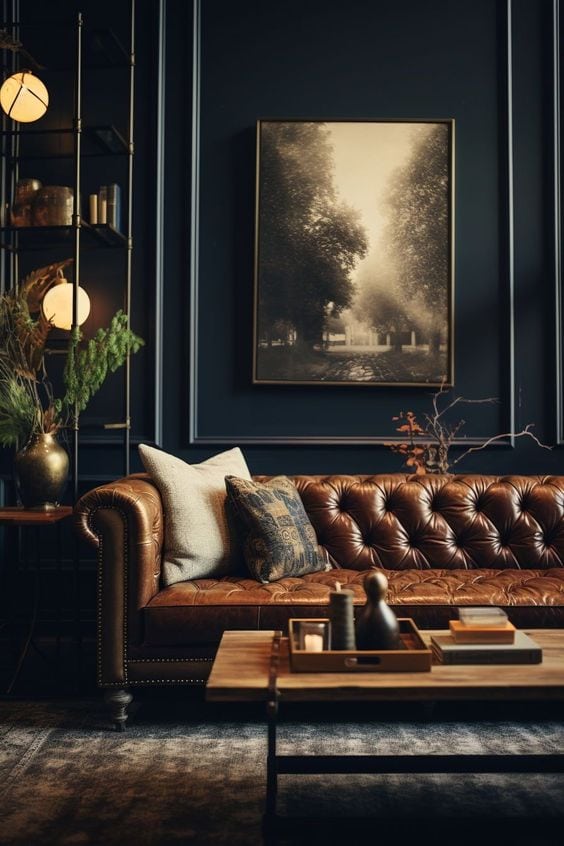
The Fundamentals of Dark and Moody Design
As an interior designer, I’ve noticed that the trend towards dark and moody spaces has been on the rise. It’s a style that can be both dramatic and sophisticated, and it can create a cozy and intimate atmosphere.
While some think of dark and moody as a dusty old castle look, you can have a very contemporary room with the same dramatic look. I personally am very drawn to the old-world monochromatic look. If you’re considering creating a dark and moody space, here are some fundamentals to keep in mind.


Understanding the Moody Trend
The moody trend is all about creating a moody and atmospheric space. It’s a style that is inspired by film noir and Gothic architecture. It’s a style that can be achieved through the use of dark hues, rich textures, and a mix of vintage and modern elements. I’m especially seeing it in kitchen trends.
The key to a successful moody space is to create a balance between light and dark, and to use texture to add depth and interest to the space.
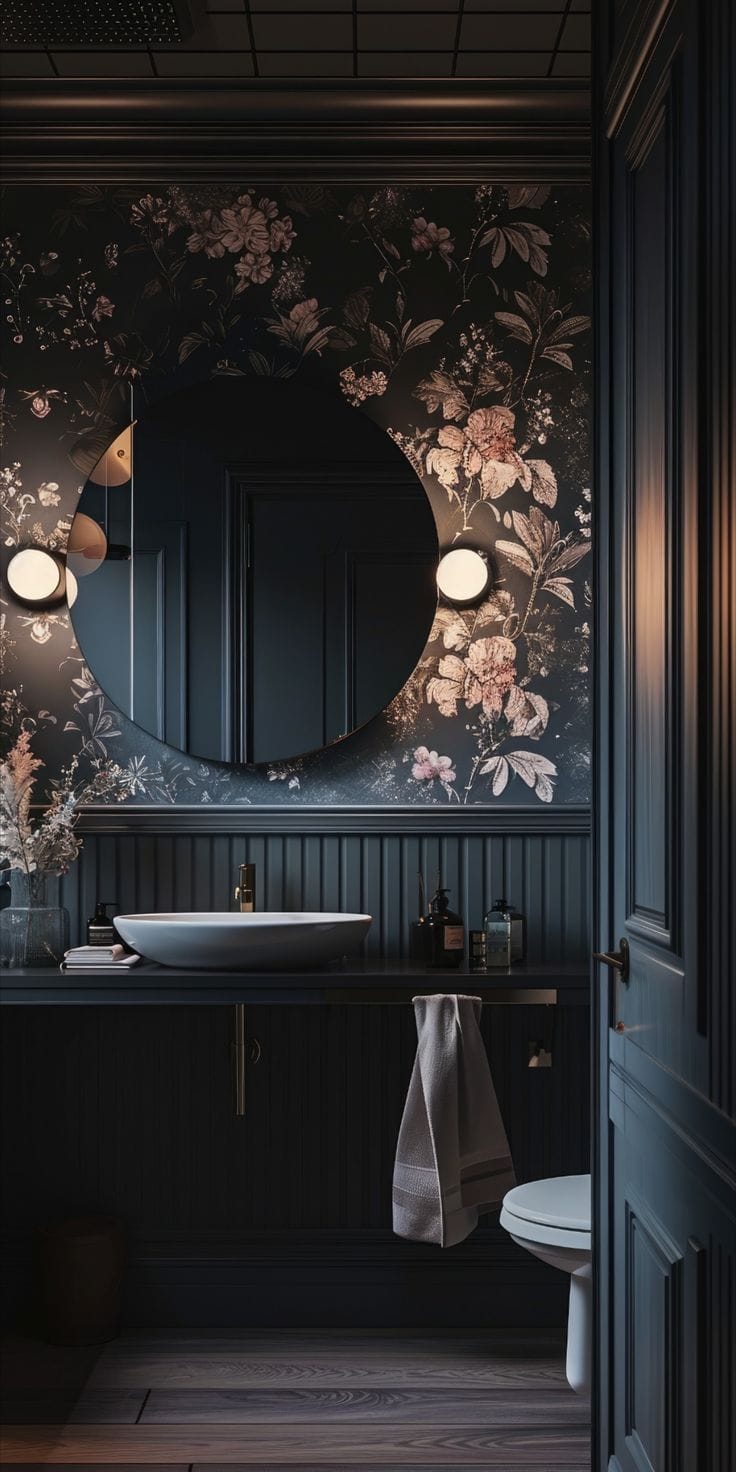
Choosing Your Base Color
When it comes to creating a dark and moody space, the base color is crucial. It will set the tone for the entire room and will be the foundation for all the other design elements. A dark color palette is a great starting point, but it’s important to choose a color that complements the style of the space.
For example, a deep blue or green can create a moody and sophisticated atmosphere, while a rich burgundy or purple can add a touch of drama. I personally would have either hunter green or navy walls in my home.
Incorporating Dark Hues and Rich Textures
Once you’ve chosen your base color, it’s time to incorporate dark hues and rich textures. This is where you can really have fun with the design. Think about incorporating materials like velvet, leather, and dark wood. These materials will add depth and texture to the space. You can also play with patterns and prints, like a dark floral or a geometric print. The key is to keep everything cohesive and balanced.
In conclusion, creating a dark and moody space can be a fun and rewarding design challenge. By understanding the moody trend, choosing the right base color, and incorporating dark hues and rich textures, you can create a space that is both stylish and cozy.
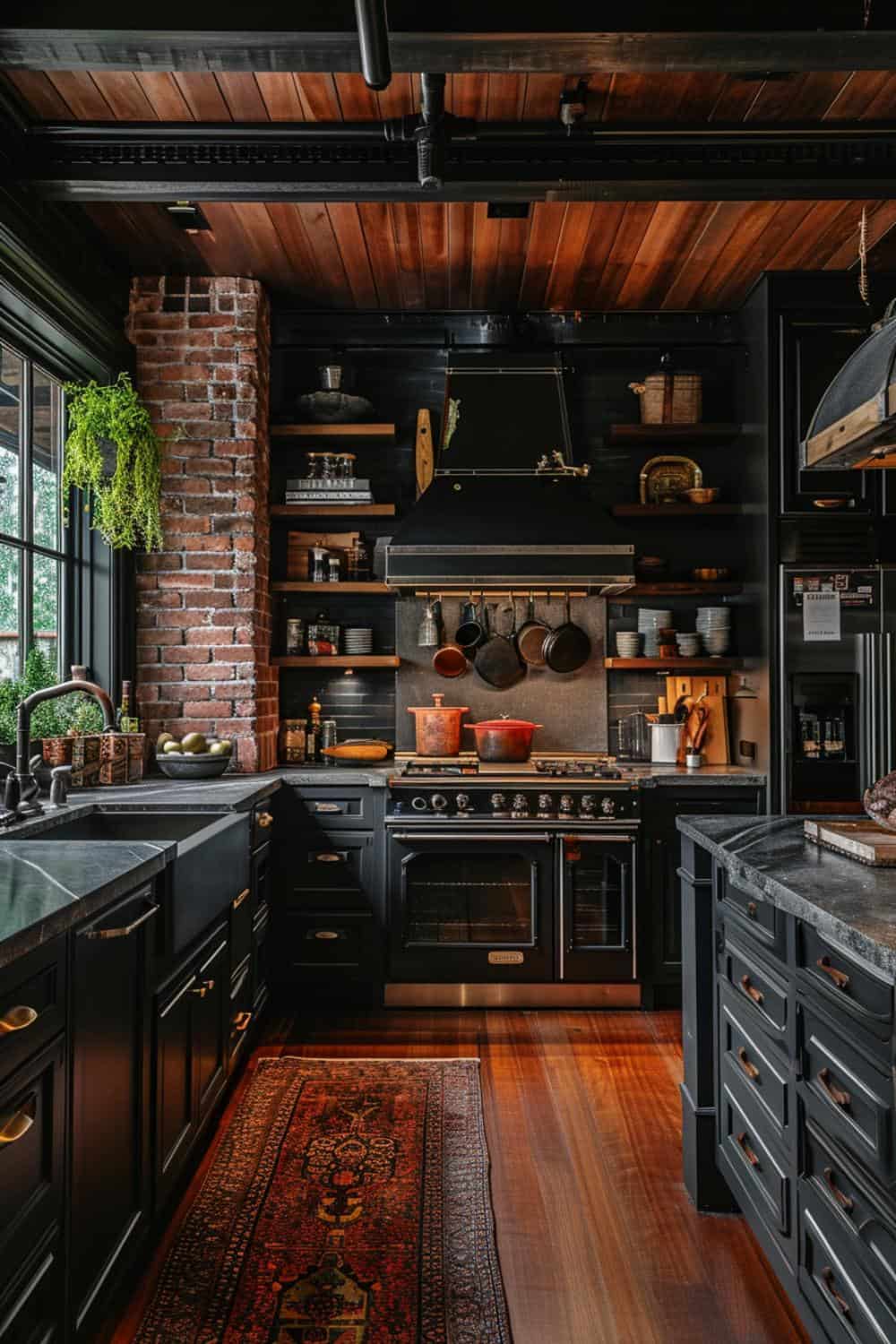
Maximizing Natural Light
As someone who loves dark and moody spaces, I know the importance of natural light in creating a balanced atmosphere. Here are a few ideas for maximizing natural light in your dark and moody interior.

Balancing Dark Walls with Light Sources
Dark walls can create a cozy and dramatic atmosphere, but they can also make a room feel smaller and closed off. To balance out the darkness, it’s important to incorporate light sources throughout the space.
Consider adding a mix of overhead lighting, such as pendant lights or chandeliers, and table or floor lamps. This will create layers of light that can be adjusted based on your mood and needs.
Another idea is to incorporate light fixtures with reflective surfaces, such as metallic or glass finishes. This will help bounce light around the room and create a brighter and more open feel.
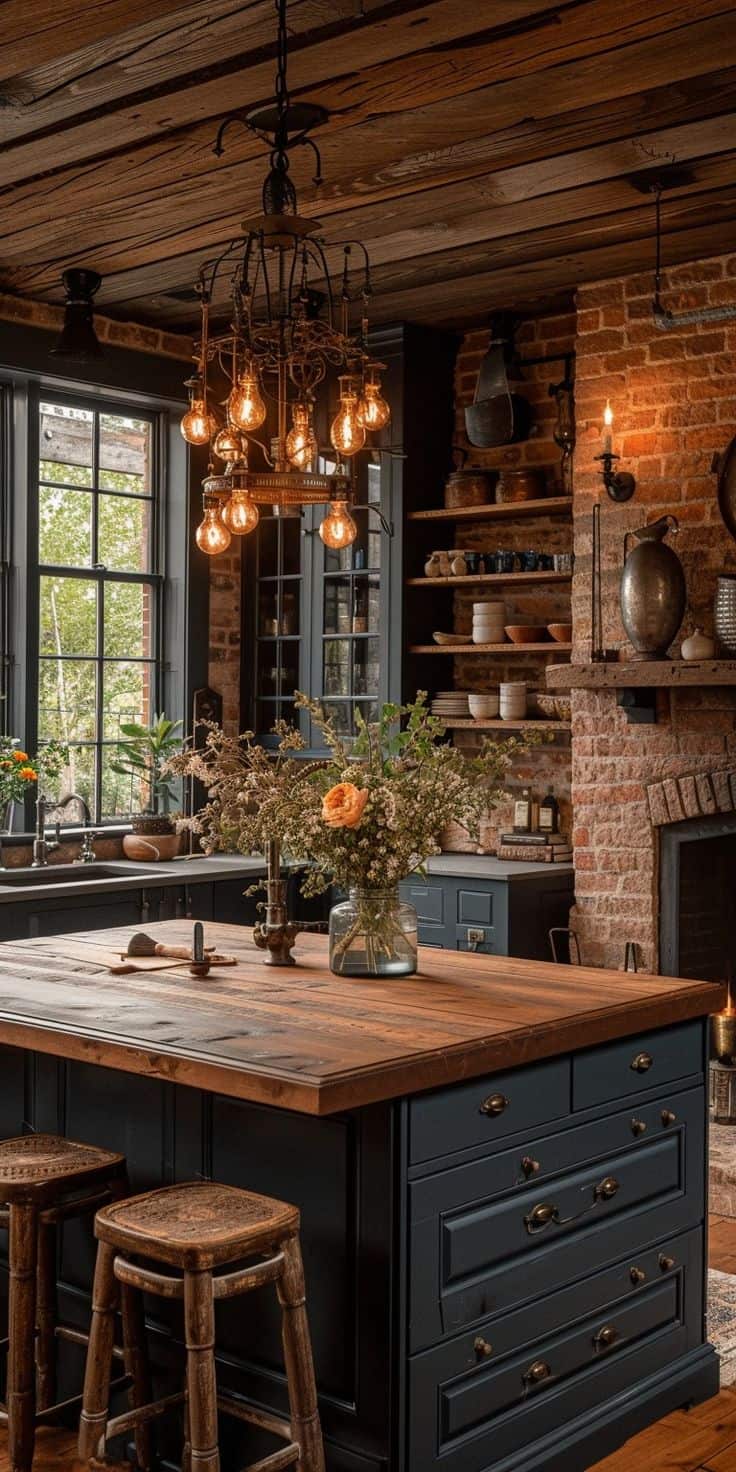
Using Reflective Surfaces to Enhance Light
In addition to light fixtures, reflective surfaces can also help enhance natural light in a dark and moody space. Mirrors are an obvious choice, but you can also incorporate other reflective surfaces such as metallic accents or glass decor.
Try placing a large mirror opposite a window to reflect the natural light and create the illusion of a bigger space. You can also add metallic accents to furniture or decor, such as a silver vase or gold-framed artwork, to catch and reflect light.
By incorporating these ideas, you can maximize natural light in your dark and moody space without sacrificing the dramatic atmosphere you love.

Creating Focal Points
As someone who loves dark and moody interior spaces, I believe that creating focal points is crucial to achieving the desired effect.
When done right, these focal points can add depth and interest to a room, drawing the eye and creating a sense of drama. Here are a few ideas for creating focal points in your own space:
Accent Walls and Statement Pieces
One of the easiest ways to create a focal point is by using an accent wall. This can be achieved by painting one wall a different color, or by using wallpaper or a textured finish. When choosing a color or pattern, consider the mood you want to create. Darker colors can add drama and sophistication, while lighter colors can create a more calming effect. I love the look of wall molding, wall panels, or wainscotting painted in rich hues. It gives depth to a moody room.
Another way to create a focal point is by using statement pieces. This could be a piece of artwork, a sculpture, or even a unique light fixture. When choosing a statement piece, think about how it will fit into the overall design of the room. It should be eye-catching, but not overpowering.

Unique Furniture and Decor Selections
Another way to create a focal point is by using unique furniture and decor selections. This could be a sofa in deep tones, a vintage rug, or a set of unusual bookshelves. When choosing these pieces, think about how they will complement the other elements in the room. They should add interest and texture, but not distract from the overall design.
In conclusion, creating focal points is an essential part of designing a dark and moody interior space. By using accent walls, statement pieces, and unique furniture and decor selections, you can add depth and interest to your space, creating a sense of drama and sophistication.
The Role of Texture and Pattern
As I’ve explored different ways to create a dark and moody interior, I’ve found that texture and pattern play a crucial role in achieving the desired effect. Here are a few things I’ve learned about using texture and pattern to create a rich and visually interesting space.
Mixing Different Textures for Depth
One of the easiest ways to add depth and interest to a space is by mixing different textures. For example, pairing a soft, plush rug with a sleek leather sofa creates a contrast that draws the eye and adds visual interest. I’ve also found that layering different textures can create a cozy and inviting atmosphere. For example, layering a wool throw over a linen sofa adds warmth and texture.
When mixing textures, it’s important to consider the overall color palette of the space. I’ve found that sticking to a monochromatic color scheme can help balance different textures and prevent the space from feeling too busy.


Patterns to Add Visual Interest
In addition to mixing textures, incorporating patterns is another way to add visual interest to a space. I’ve found that using a mix of large and small patterns can create a dynamic and visually appealing space. For example, pairing a large floral wallpaper with a small geometric rug can create a playful and unexpected combination.
When using patterns, it’s important to consider the scale and placement. I’ve found that using large-scale patterns on a single accent wall can create a dramatic focal point, while smaller patterns can be used more liberally throughout the space.
Overall, texture and pattern are essential elements in creating a dark and moody interior. By mixing different textures and incorporating patterns, you can create a space that is visually interesting and rich in depth and texture.
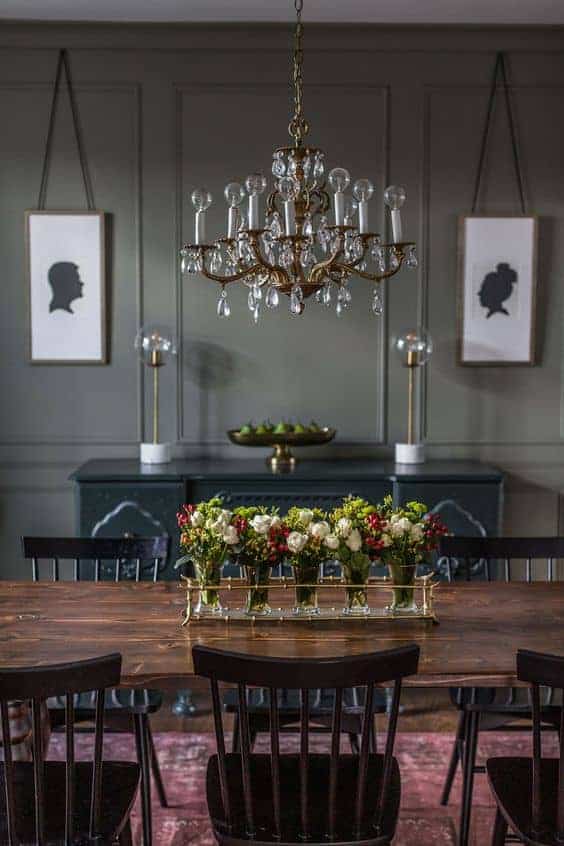
Color Schemes and Paint Choices
Selecting Dark Paint Colors
When it comes to creating a dark and moody interior space, the color scheme is one of the most important elements to consider. Dark paint colors can add depth and character to a room, but it’s essential to choose the right shades and tones to achieve the desired effect.
I recommend selecting paint colors that are rich and deep, such as deep blues, forest green, or charcoal gray. These colors can create a cozy and intimate atmosphere, perfect for a bedroom or living room.
It’s also important to consider the room’s lighting when selecting paint colors. If the room doesn’t receive a lot of natural light, it’s best to avoid colors that are too dark or heavy, as they can make the room feel smaller and more like a dark cave.
Combining Different Shades and Tones
To create a truly dynamic and visually engaging space, consider combining different shades and tones of dark paint colors. For example, you could paint one wall a deep navy blue and another wall a lighter shade of blue-gray. This creates a subtle contrast that adds depth and interest to the room.
Another option is to use a monochromatic color scheme, using different shades of the same color. This can create a sophisticated and cohesive look, perfect for a modern or minimalist space.
When combining different shades and tones, it’s essential to consider the overall color palette of the room. Make sure the colors complement each other and don’t clash or overwhelm the space.
You also have to take into consideration the size of your living space, where you live, and the different light that you get in your spaces. You can have light walls and still get that moody home decor feel if your room has windows in the north or northwest. If you live where the weather is mostly dark and gray. Homes that I see in Northern Sweden or the English Countryside have bright interiors but the climate lends itself to a dark space where a candle burning all day creates moody interiors.
In summary, selecting the right dark paint colors and/or combining different shades and tones can be a powerful tool for creating a moody and atmospheric interior space. With a little creativity and experimentation, you can transform any room into a cozy and inviting retreat.

Strategic Use of Space and Structure
As someone who loves dark and moody interior spaces, I’ve found that strategic use of space and structure can make a big impact. Here are a few tips I’ve picked up along the way.
Furniture Arrangement in Small Spaces
In small spaces, furniture arrangement is key. To create a cozy and intimate atmosphere, I like to arrange furniture in a way that encourages conversation and relaxation. This often means opting for a few larger pieces of furniture instead of many smaller ones.
Another trick is to use furniture with hidden storage, such as ottomans or benches with built-in storage compartments. This helps to keep clutter at bay and makes the space feel more open.
Utilizing High Ceilings and Big Windows
If you’re lucky enough to have high ceilings and big windows, make the most of them! High ceilings can make a space feel grand and airy, while big windows let in lots of natural light.
To really play up these features, consider painting the ceiling a darker color than the walls. This creates a cozy, cocoon-like feeling that is perfect for a dark and moody interior.
When it comes to window treatments, I prefer simple, unobtrusive options like sheer curtains or blinds that can be easily opened or closed. This allows me to control the amount of natural light in the space and lets the windows themselves take center stage. That being said adding a curtain with a dramatic floral print can create a more cozy and finished look to a room. I recently discovered this when I switched out the sheers in my great room for a floral linen window treatment.
Accessorizing and Detailing
When it comes to creating a dark and moody interior space, the accessories and details you choose can make a big impact. Here are a few ideas to consider:
Light Fixtures and Window Treatments
Light fixtures and window treatments can help set the mood in a room. Consider opting for fixtures with dimmer switches so you can adjust the lighting as needed. For window treatments, choose heavier fabrics in darker colors to block out more light and add to the overall ambiance.
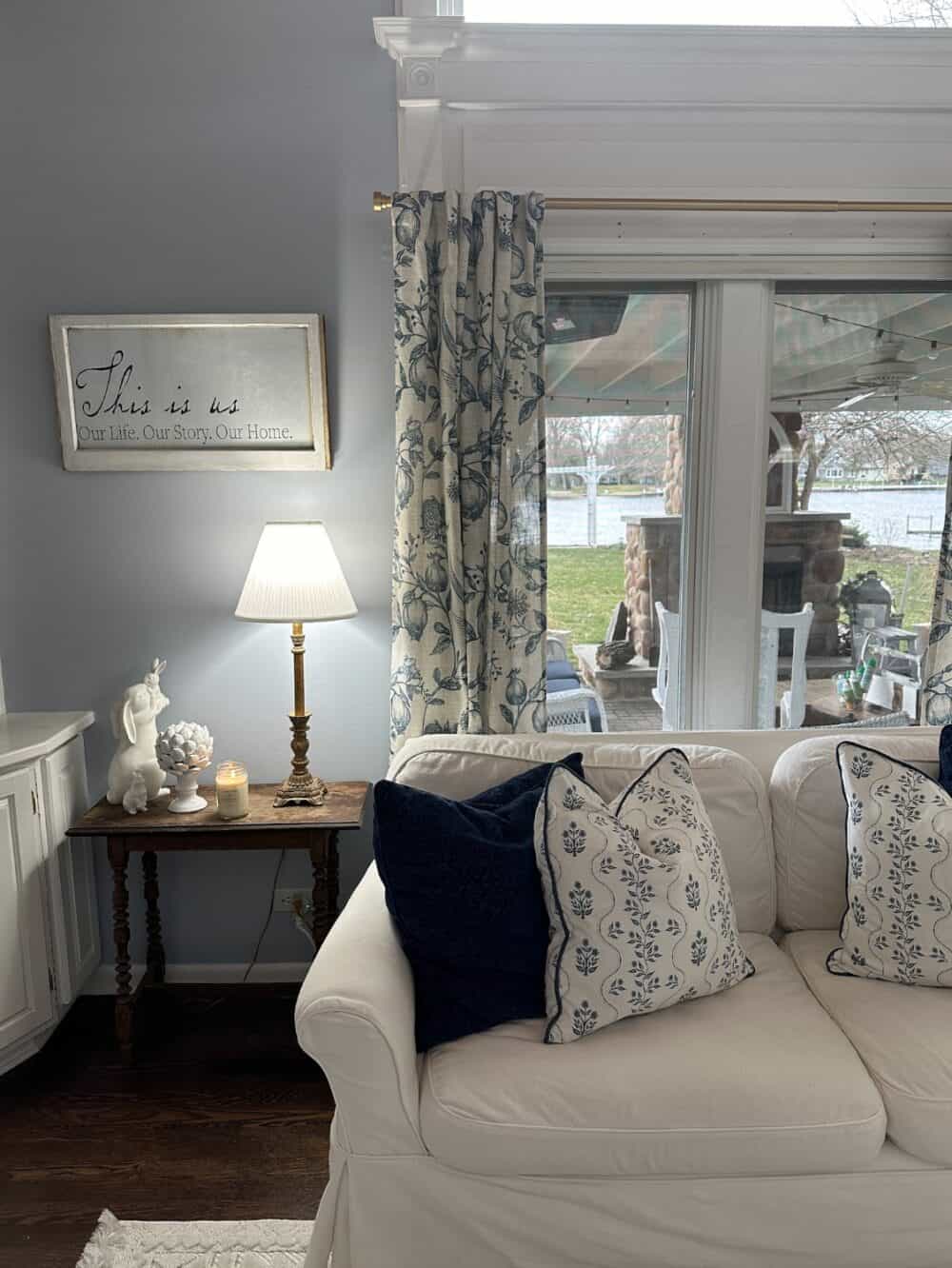
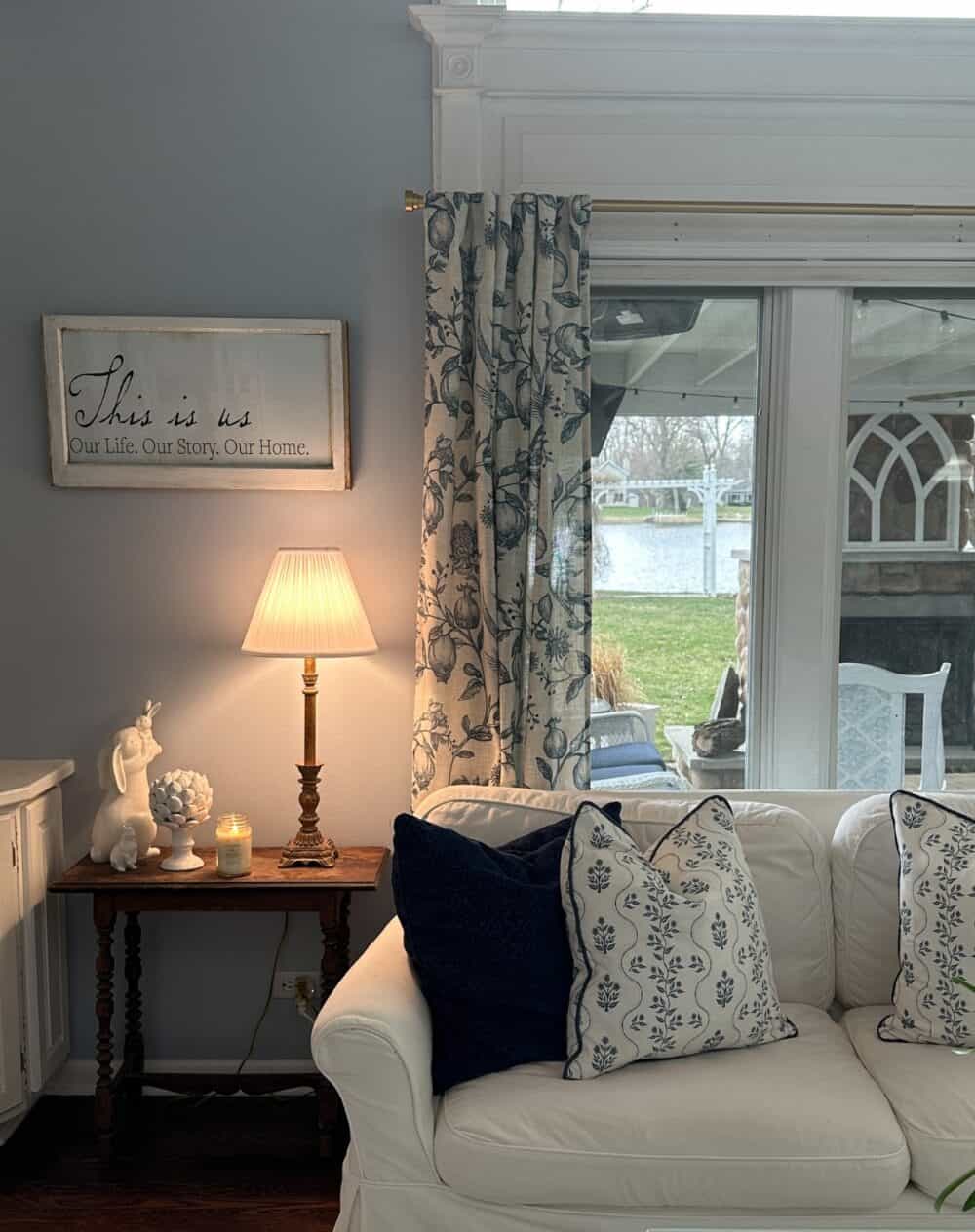
Also don’t underestimate the power of a light bulb. For a long time I had a very white light bulb in my lamps. I recently switched them out for a different bulb that I can only describe as glowing! It immediately changed the feel of my space.
Natural Elements and Materials
Incorporating natural elements and materials into your decor can help add texture and depth to a room. Consider adding a few potted plants, a wooden accent piece, or a stone sculpture to your space. Additionally, using natural materials like leather, wool, and linen in your upholstery and decor can help create a warm and cozy feel.
When accessorizing and detailing a dark and moody interior space, it’s important to keep in mind the overall aesthetic you’re trying to achieve. By choosing the right light fixtures, window treatments, and natural elements and materials, you can create a space that’s both stylish and inviting.

Implementing the Dark and Moody Style in Different Rooms
The dark and moody look can be implemented in a variety of rooms in your home. Here are some ideas to get you started:
Designing a Moody Living Room
The living room is often the central gathering place in a home, so it’s a great place to experiment with the dark and moody style. One way to achieve this look is by incorporating dark colors like charcoal, navy, or black into your furniture and decor. Consider adding a plush velvet sofa in a deep shade, or hanging dark curtains to create a cozy atmosphere. You can also add texture with a shaggy rug or woven throw pillows.
Art work is also a way to make a living room look more moody. Adding some prints that look like oil paintings can be an inexpensive way to get the same look and feel as the real thing.
To balance out the darkness, add some light-colored accents like a lighter wooden coffee table. You can also incorporate metallic accents like brass or gold to add some shine and interest.
Transforming the Dining Room and Home Office
The dining room and home office are two other spaces where you can experiment with the dark and moody style. In the dining room, consider painting the walls a deep shade of blue or green, or adding a dark wood dining table. You can also incorporate moody lighting with a chandelier or pendant lights.
In the home office, consider painting the walls a dark color to create a cozy and productive atmosphere. You can also add a dark wood desk and shelves to create a cohesive look. To balance out the darkness, add some light-colored accents like a white chair or light-colored artwork.

Create a Cozy Powder Room
The powder room is a small space that can pack a big punch when it comes to design. To create a dark and moody powder room, consider adding drama with wallpaper a deep shade of black or navy. You can also add a dark wood vanity and mirror to create a cohesive look. To balance out the darkness, add some light-colored accents like a white sink or light-colored towels.
The powder room is one area in my home, that is white and bright, where I’m thinking of adding some dark dramatic wallpaper. It will create a not-at-all-expected bold statement.
In Conclusion
In conclusion, the dark and moody style can be implemented in a variety of rooms in your home. By incorporating dark colors, textures, and metallic accents, you can create a cozy and inviting space that reflects your personal style.
While I don’t think my house would ever look appropriate or right with a dark and moody look, I think I can change a few things here and there to give me a glimpse of it
Am I the only one who could own 10 homes and have a different style in each house?
Peace and Love,
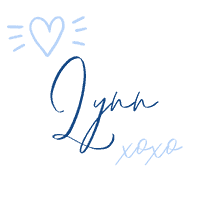

Meet Me
I’m an Interior Designer, Professional Organizer, and Party Planner who lives in the suburbs of Chicago in a 1,300 sq., ft., home with my “Handy” husband, Keith.
I’m an open book about my life on my blog. Find out more about me by tapping the button below.

Thanks for Following Along
If you enjoyed this post I hope you sign up to be a friend of Living Large in A Small House! Then you won’t miss any of the inspiration that is shared with you each week! You can also follow me on Instagram, Facebook, and YouTube. I share even more inspiration on Pinterest! You can listen to me chat on my Podcast.


A great way to save this article is to save it to your Pinterest boards. You can find the pin button in the top right corner of the photo below. Also, don’t forget to follow me on Pinterest
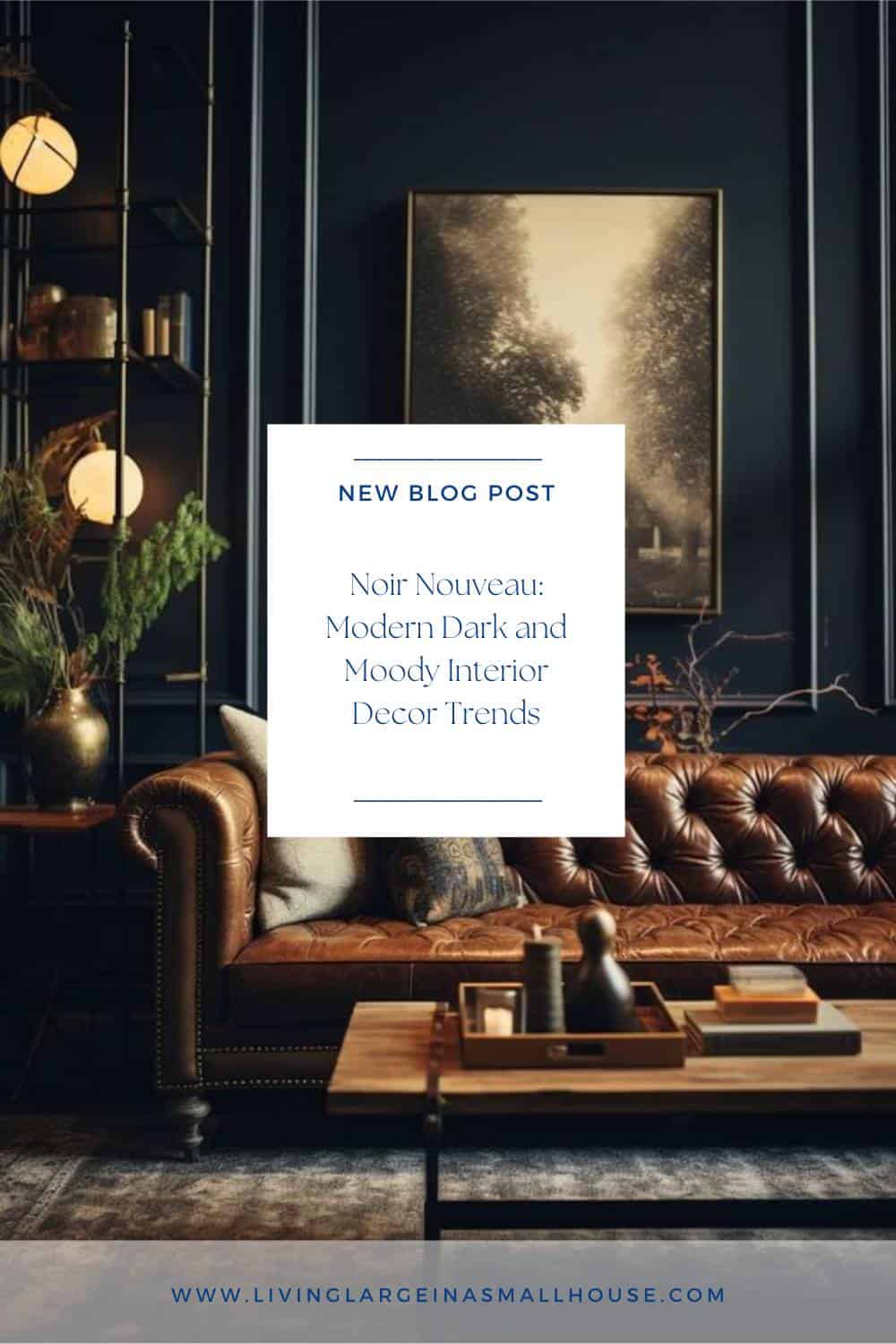



Featured

Web Story


